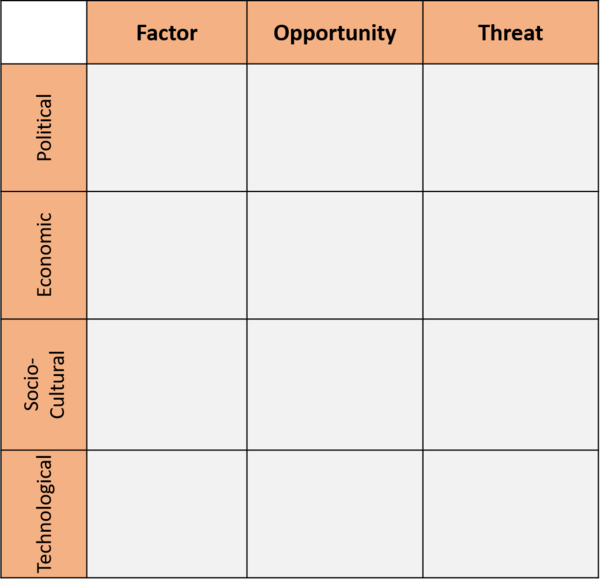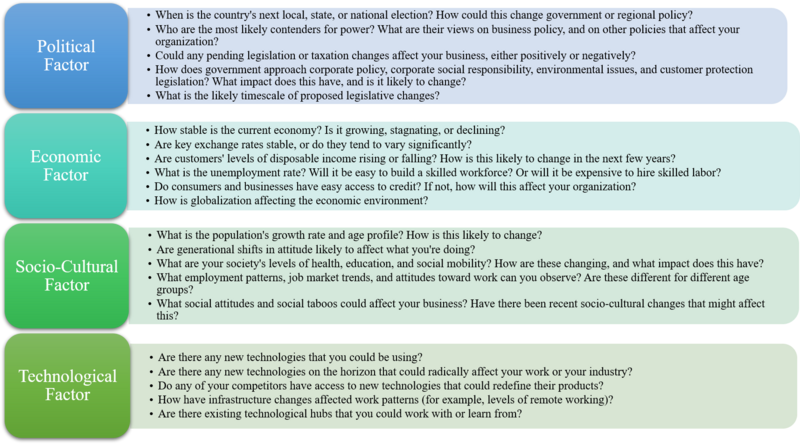Atkins APPPM
Cloefierri (Talk | contribs) (→PEST Analysis Model) |
Cloefierri (Talk | contribs) (→PEST Analysis Model) |
||
| Line 47: | Line 47: | ||
3. Then, a last brainstorm is done about threats/issues caused by opportunities. | 3. Then, a last brainstorm is done about threats/issues caused by opportunities. | ||
| − | |||
| − | |||
[[File:PEST_1.png|800px|Figure 1 : PEST Analysis Brainstorming]] | [[File:PEST_1.png|800px|Figure 1 : PEST Analysis Brainstorming]] | ||
| + | |||
| + | The following figure is a document that can be fulfilled during this 3 steps : | ||
| + | [[File:PEST 2.png|600px]] | ||
---- | ---- | ||
Revision as of 13:12, 6 March 2020
Group name : Lecanaj
Introduction
Atkins Denmark is an engineering consultancy firm with around 400 employees in Denmark. They provide consultancy primarily on civil engineering work such as road and trail projects. Atkins Denmark's primary resource is delivering their expertise to the client. The aim of this project is to handle the problem that Atkins Denmark are forced to deliver their expertise to the client in a more efficient and better way in order to keep up with the competition on the market. A method for achieving this can be to implement digitisation in the for of internal digital project management practices in the company.
This wiki article is a collection of management tool that our group can use to analyse the digitalization of Atkins.
Management tools
The different tools developed in this article below are divided in categories :
1. Change Management : - Kotter
- Lewin
- PEST Analysis Model
- Maslow Hierarchy of needs
- Managing Change: A process perspective
- Expectancy theory and the motivation to support or resist change
2. Stakeholder Management : - Influence and Interest Stakeholder Matrix
- Miles’ four stakeholder classes (influencer, collaborator, claimants, recipients)
- Mitchell’s categorization of stakeholders (Power, Legitimacy, Urgency)
- Ladder of engagement
3. Project Management :
a) Purpose : - Golden Circle (Why, How and What)
- SWOT Model
- Key Performance Indicators(KPI)
- Benefits Realization Management to Maximize Project Effectiveness (BRM)
b) Complexity : - Optimism bias, strategic misinterpretation and reference class forecasting
c) Uncertainty : - Management of Project Change
Kotter
Lewin
PEST Analysis Model
The PEST Analysis is a change management tool useful for revealing the direction of change in the business environment and to develop an objective view of this environment. It helps to shape what a company is doing in order to work with change instead of working against the change. To use the pest analysis, and analyse the business environment, the opportunities and the threats, we have to follow the 3 different steps:
1. First the PEST model is used to brainstorm the changes. The 4 factors discussed in this phase are explained in figure 1. The questioning will be guided by this figure.
2. After that, a second brainstorm is made dealing with the opportunities arising from each of these changes.
3. Then, a last brainstorm is done about threats/issues caused by opportunities.
The following figure is a document that can be fulfilled during this 3 steps :

Maslow Hierarchy of needs
Managing Change: A process perspective
Expectancy theory and the motivation to support or resist change
Influence and Interest Stakeholder Matrix
Miles’ four stakeholder classes (influencer, collaborator, claimants, recipients)
Mitchell’s categorization of stakeholders (Power, Legitimacy, Urgency)
Ladder of engagement
Golden Circle (Why, How and What)
SWOT Model
Key Performance Indicators(KPI)
Benefits Realization Management to Maximize Project Effectiveness (BRM)
Optimism bias, strategic misinterpretation and reference class forecasting
Management of Project Change
For each tool :
- Explain the use of the tool (definition, overview)
- Why you choose this specific tool? (Importance)
- What sort of problem can it solve?
- How this tool is relative with your case?
- References
==
